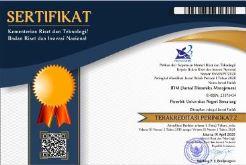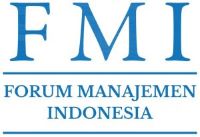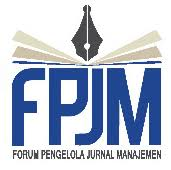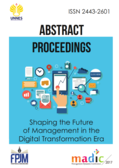Competitive Advantage and Firm Performance: Debt Financing as a Moderating Variable
Abstract
This study aims to examine the moderating role of debt financing in the effect of competitive ad- vantage on the performance of Lasem-Rembang batik MSMEs. Capital from debt is expected to optimize the role of competitive advantage to strengthen firm performance. The researchers used primary data through a survey of 68 batik MSME entrepreneurs who have been operating for at least 5 years. The data was processed using Partial Least Squares-Structural Equation Model (PLS)-SEM with the WarpPLS 7.0 application by including the control variable of entrepreneur education level. The findings show that competitive advantage is not proven to have a positive effect on the perfor- mance of MSMEs; on the contrary, it has a significant negative effect. Then debt financing is demon- strated to moderate the effect of competitive advantage on MSME performance. This implies that debt financing can strengthen the effect of competitive advantage on MSME performance because it produces a positive and significant effect.
Keywords
Full Text:
PDFReferences
Acar, F. P. (2016). The Effects Of Top Management Team Composition on SME Export Performance: an Upper Echelons Perspective. Central European Journal of Operations Research, 24(4), 833-852.
Akingunola, R. O. (2011). Small and Medium Scale Enterprises and Economic Growth in Nigeria: an Assessment of Financing Options. Pakistan Journal of Business Economic Review, 2(1), 78-97.
Alvarado, M., & Mora-Esquivel, R. (2020). Financial bootstrapping among Costa Rican Small Businesses: an Exploratory Study. Tec Empresarial, 14(1), 1-10.
Alvarez, S. A., & Barney, J. B. (2002). Resource‐based Theory and the Entrepreneurial Firm. In Michael A. Hitt, R. D. Ireland, S. M. Camp, & D. L. Sexton (Eds.), Strategic entrepreneurship: Creating a new Mindset (Vol. First Edition, pp. 89-105). USA: Blackwell Publishing Ltd.
Arbawa, D. L., & Wardoyo, P. (2018). Keunggulan Bersaing: berpengaruh terhadap Kinerja Pemasaran (Studi Pada UMKM Makanan dan Minuman di Kabupaten Kendal). Jurnal Riset Ekonomi dan Bisnis, 11(1), 56-75.
Argote, L., & Ingram, P. (2000). Knowledge Transfer: a Basis for Competitive Advantage in Firms. Organizational Behavior Human Decision Processes, 82(1), 150-169.
Barney, J. (1991). Firm Resources and Sustained Competitive Advantage. Journal of Management, 17(1), 99-120.
Basu, A., & Parker, S. C. (2001). Family Finance and New Business Start‐ups. Oxford Bulletin of Economics and Statistics, 63(3), 333-358.
Błach, J., Wieczorek-Kosmala, M., & Trzęsiok, J. (2020). Innovation in SMEs and Financing Mix. Journal of Risk Financial Management, 13(9), 1-19.
Caballero-Morales, S.-O. (2021). Innovation as Recovery Strategy for SMEs in Emerging Economies during the COVID-19 Pandemic. Research in International Business, 57, 1-9.
Carayannopoulos, S. (2017). Small, Young Firm Flexibility and Performance in the Context of Disruptive Innovations. International Journal of Entrepreneurship Innovation Management, 21(1-2), 105-118.
Cardone, R. C., & Casasola, M. J. (2003). What do we Know about the Financial Behaviour of the Spanish SME?: an Empirical Analysis.
Chemmanur, T. J., & Fulghieri, P. (2014). Entrepreneurial Finance and Innovation: An Introduction and Agenda for Future Research. Review of Financial Studies, 27(1), 1-19.
Dawa, S., & Namatovu, R. (2014). Self-finance–application of the Restricted Pecking Order Theory among Ugandan Women Entrepreneurs. International Journal of Entrepreneurship Small Business, 21(4), 513-526.
Eldridge, D., Nisar, T. M., & Torchia, M. (2019). What Impact Does Equity Crowdfunding have on SME Innovation and Growth? an Empirical Study. Small Business Economics(56), 105-120.
Elrehail, H., Harazneh, I., Abuhjeeleh, M., Alzghoul, A., Alnajdawi, S., & Ibrahim, H. M. H. (2019). Employee Satisfaction, Human Resource Management Practices and Competitive Advantage: The Case of Northern Cyprus. European Journal of Management Business Economics, 29(2), 125-149.
Eniola, A. A. (2018). Entrepreneur-SME Manager Traits and Sources of Financing. In L.-P. Dana, V. Ratten, & B. Q. Honyenuga (Eds.), African entrepreneurship. Challenges and Opportunities for Doing Business (pp. 223-259). Cham, Switzerland: Springer International Publishing AG.
Eniola, A. A., & Ektebang, H. (2014). SME Firms Performance in Nigeria: Competitive Advantage and its Impact. International Journal of Research Studies in Management, 3(2), 75-86.
Ferreira, J. J., Azevedo, S. G., & Ortiz, R. F. (2011). Contribution of Resource-based View and Entrepreneurial Orientation on Small Firm Growth. . Cuadernos de Gestión, 11(1), 95-116.
Fiegenbaum, A., & Karnani, A. (1991). Output flexibility—a Competitive Advantage for Small Firms. Strategic Management Journal, 12(2), 101-114.
Fraser, S., Bhaumik, S. K., & Wright, M. (2015). What do We Know about Entrepreneurial Finance and its Relationship with Growth? International Small Business Journal, 33(1), 70-88.
Goujard, A., & Guérin, P. (2018). Financing Innovative Business Investment in Poland. Paper Presented at the OECD Economics Department Working Papers, Paris. https://www.oecd-ilibrary.org/content/paper/d7605f72-en
Grant, R. M. (1991). The Resource-based Theory of Competitive Advantage: Implications for Strategy Formulation. California Management Review, 33(3), 114-135.
Harrison, N., & Watson, T. (1998). The Focus for Innovation in Small and Medium Service Enterprises. Paper Presented at the Proceedings of the Twenty-seventh Annual Meeting of the Western Decision Sciences Institute: April 7-11, 1998, Harrah’s and Hampton Inn at Harrah’s, Reno, Nevada.
Haryono, A. T., & Fathoni, A. (2017). Potensi Batik Lasem sebagai Upaya Pengembangan Ekonomi Kreatif untuk Meningkatkan Keunggulan Kompetitif Berkelanjutan di Kecamatan Lasem Kabupaten Rembang. Jurnal Ekonomi dan Bisnis Kontemporer, 3(2), 1-29.
Herath, H., & De Silva, S. (2011). Strategies for Competitive Advantage in Value Added Tea Marketing. Tropical Agricultural Research, 22(3), 251 - 262.
Herman. (2021, August 12). Hipmi Sebut Banyak UMKM Masih Kesulitan Akses Kredit Perbankan. Berita Satu. Retrieved from https://www.beritasatu.com/ekonomi/782243/hipmi-sebut-banyak-umkm-masih-kesulitan-akses-kredit-perbankan
Huang, C., & Liu, Z. (2014). Analysis on Financing Difficulties for SMEs due to Asymmetric Information. Global Disclosure of Economics and Business, 3(1), 77-80.
Hung, R. Y.-Y. (2006). Business Process Management as Competitive Advantage: a Review and Empirical Study. Total Quality Management Business Excellence, 17(1), 21-40.
Ismail, A. I., Rose, R. C., Uli, J., & Abdullah, H. (2012). The Relationship between Organisational Resources, Capabilities, Systems and Competitive Advantage. Asian Academy of Management Journal, 17(1), 151-173.
Kon, Y., & Storey, D. J. (2003). A Theory of Discouraged Borrowers. Small Business Economics, 21(1), 37-49.
Kraja, Y., & Osmani, E. (2013). Competitive Advantage and its Impact in Small and Medium Enterprises (SMEs)(Case of Albania). European Scientific Journal, 9(16), 76-85.
Krajňáková, E., Navikaitė, A., & Navickas, V. (2015). Paradigm Shift of Small and Medium-Sized Enterprises Competitive Advantage to Management of Customer Satisfaction. Inzinerine Ekonomika-Engineering Economics,, 26(3), 327-332.
Kristianus, A. (2021, August 12). Menkop UKM: Masih Banyak Pelaku UMKM Kesulitan Akses Pembiayaan. Investor.id. Retrieved from https://investor.id/business/menkop-ukm-masih-banyak-pelaku-umkm-kesulitan-akses-pembiayaan
Lawless, M., O’Connell, B., & O’Toole, C. (2015). SME Recovery Following a Financial Crisis: Does Debt Overhang Matter? Journal of Financial Stability, 19, 45-59.
Leach, J. C., & Melicher, R. W. (2011). Entrepreneurial finance: Cengage Learning.
Lee, S., Kim, B. G., & Kim, H. (2012). An Integrated View of Knowledge Management for Performance. Journal Of Knowledge Management, 16(2), 183-203.
Maharani, M., Maupa, H., & Aswan, A. (2020). Knowledge Management dan Aspek Kewirausahaan terhadap Kinerja melalui Keunggulan Bersaing UKM di Kota Makassar. Hasanuddin Journal of Applied Business Entrepreneurship & Regional Development, 3(1), 27-35.
Maulany, N. N., & Masruroh, N. N. (2017). Kebangkitan Industri Batik Lasem di Awal Abad XXI. . Patrawidya, 18(1), 1-12.
Miller, A., Gartner, W. B., & Wilson, R. (1989). Entry Order, Market Share, and Competitive Advantage: A Study of Their Relationships in New Corporate Ventures. Journal of Business Venturing, 4(3), 197-209.
Ndemi, E. G., & Mungai, J. (2018). Formal Credit Financing and Financial Performance of Small and Medium Enterprises in Nanyuki town, Kenya. International Academic Journal of Economics Finance, 3(2), 179-196.
Ndlovu, N., Shumba, V., & Vakira, E. (2018). The Influence of Experience and Owner-Managers Education on SME Performance: Case of Motor Spares Enterprises at Kelvin Light Industries in Bulawayo. Journal of Economics Behavioral Studies, 10(4 ), 22-31.
Ojo, M. O. (1995). The Challenges for Economic Management in Nigeria. Economic Financial Review, 33(2), 90-110.
Powers, T. L., & Hahn, W. (2004). Critical Competitive Methods, Generic Strategies, and Firm Performance. International Journal of Bank Marketing, 22(1), 43-66.
Prabowo, T., Witurahmi, S., & Ismaryati. (2006). Pengembangan Industri Batik di Lasem sebagai upaya Revitalisasi Seni Rupa Tradisional dan Peningkatan Ketahanan Budaya berbasis Pariwisata. Lembaga Penelitian dan Pengabdian Kepada Masyarakat, Universitas Sebelas Maret.
Ramadani, V. (2012). The Importance of Angel Investors in Financing the Growth of Small and Medium Sized Enterprises. International Journal of Academic Research in Business Social Sciences, 2(7), 306-322.
Ratnawati, R. (2016). Tingkat Pendidikan, Pengetahuan Literasi Keuangan, Sustainability Usaha sebagai Upaya Meningkatkan Kinerja Manajemen UKM. Vidya, 24(2), 24-32.
Rita, M. R. (2019). Financial Bootstrapping: External Financing Dependency Alternatives for SMEs. Jurnal Ekonomi dan Bisnis, 22(1), 83-100.
Rita, M. R., Kristanto, A. B., Nugrahanti, Y. W., & Utomo, M. N. (2021). Entrepreneurial Orientation and Emotional Bias in MSMEs’ Financing and Performance. Jurnal Ekonomi dan Bisnis, 24(2), 237-270.
Rita, M. R., & Thren, A. T. (2019). A Three-dimensional model of MSME Performance: an Agenda for Further Research. Bisma, 12(1), 1-14.
Roliza, P. (2017). Pengaruh Inovasi terhadap Keunggulan Bersaing yang Dimoderasi oleh Variabel Umur Perusahaan pada Usaha Mikro Kecil dan Menengah (UMKM) Sektor Kuliner di Kota Padang. Universitas Andalas, Padang, Sumatera Barat. Retrieved from http://scholar.unand.ac.id/27972/
Sak, G., & Taymaz, E. (2021). How Flexible are Small Firms? An Analysis on the Determinants of Flexibility. Ekonomik Yaklasim, 32(118), 1-25.
Serrasqueiro, Z., Leitão, J., & Smallbone, D. (2018). Small-and Medium-Sized Enterprises (SME) Growth and Financing Sources: Before and after the Financial Crisis. Journal Of Management Organization, 27(1), 6-21.
Setyawan, N. A. (2021). The Existence of Lasem Batik Entrepreneurs during the Covid-19 Pandemic. Admisi dan Bisnis, 22(1), 61-72.
Suci, N. M., Yulianthini, N. N., & Mayasari, N. M. D. A. (2019). Debt Financing Behavior of SME’s Entrepreneurs. Paper Presented at the 3rd International Conference on Tourism, Economics, Accounting, Management, and Social Science.
Wang, Y. (2016). Bringing the Stages Back in: Social Network Ties and Start‐up firms’ access to Venture Capital in China. Strategic Entrepreneurship Journal, 10(3), 300-317.
Wernerfelt, B. (1995). The Resource‐based View of the Firm: Ten Years After. Strategic Management Journal, 16(3), 171-174.
Wu, J., Si, S., & Wu, X. (2016). Entrepreneurial Finance and Innovation: Informal Debt as an Empirical Case. Strategic Entrepreneurship Journal, 10(3), 257-273.
Wulandari, S., Maslichah, M., & Afifudin, A. (2021). Pengaruh Tingkat Pendidikan, Aksesibilitas Kredit, Kemampuan Menyusun dan Menyajikan Laporan Keuangan, serta Minat Penggunaan E-Commerce terhadap Kinerja UMKM (Studi Pada UMKM di Kota Malang). Jurnal Ilmiah Riset Akuntansi, 10(08), 1-11.
Yanuarta, R., & Krismanola, I. (2021). Pengaruh Preferensi Sumber Pembiayaan dan Tingkat Pendidikan terhadap Pendapatan Usaha Mikro dan Kecil di Indonesia. Jurnal Kajian Manajemen dan Wirausaha, 3(2), 88-101.
View Counter: Abstract - 1266 and PDF - 1168
Refbacks
- There are currently no refbacks.






